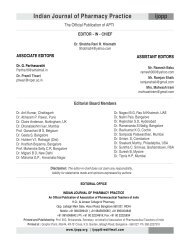Oct-Dec, 2011 - Indian Journal of Pharmacy Practice
Oct-Dec, 2011 - Indian Journal of Pharmacy Practice
Oct-Dec, 2011 - Indian Journal of Pharmacy Practice
- No tags were found...
Create successful ePaper yourself
Turn your PDF publications into a flip-book with our unique Google optimized e-Paper software.
Satyanarayana V - Evaluation <strong>of</strong> the Impact <strong>of</strong> a Therapeutic Management and Effect <strong>of</strong> Pharmacist Intervention on Children with AsthmaTable 4: Prescription Analysis (II) by pre-intervention and post-intervention dataArea <strong>of</strong> Pre- Post- F-test t-test ResultIntervention Intervention Intervention (p>0.05) (95%(n=50) (n=50) C.I)Number <strong>of</strong> drugs 330 283 0.5775 1.12 to1.37 NSNumber <strong>of</strong> drugs prescribed in generics 220 227 0.4421 1.21 to 1.55 NSNumber <strong>of</strong> antibiotics 100 92 0.3021 1.38 to 1.44 NSNumber <strong>of</strong> Tablets 110 74 0.0274 1.22 to 1.66 NSNumber <strong>of</strong> Nebulizations 100 100 0.5141 1.11 to o.99 NSNumber <strong>of</strong> Cough syrups 22 19 0.2412 0.21 to 0.14 NSNumber <strong>of</strong> Oxygen inhalations 50 50 0.2141 0.12 to 0.11 NSNumber <strong>of</strong> Irrational prescribing 161 93 9.22 0.87 to 0.66 SANOVA: Degree <strong>of</strong> freedom =49; Table value <strong>of</strong> F-test=3.76 at 95% confidence limits, N/S =Not Significant;S=Significant. No. <strong>of</strong> irrational prescribed – is determined based on WHOFig. 3: Prescription Analysis (iI) by pre-intervention andpost-intervention datagroup compared to the control group. The data suggest thathaving pharmacists provide pharmaceutical care for pediatric32patients with asthma results in a favorable outcome .Lincy SL described that pediatric pharmaceutical care is still anew concept in the pharmacy pr<strong>of</strong>ession. In an effort to rectifythis situation metered-dose inhaler technique, to determinefrequency <strong>of</strong> MDI assessment and teaching behavior and toassess the effect <strong>of</strong> asthma pharmaceutical care educational33programmers .D Barbanel et al; 2003, was undertaken a randomizedcontrolled study to determine whether a communitypharmacist could improve asthma control using selfmanagementadvice for individuals recruited during34attendance at a community pharmacy .K<strong>of</strong>fi N. et.at, conducted study to assess the role <strong>of</strong>pharmacists in management <strong>of</strong> asthma in Africa. Thisquestionnaire survey was conducted. Participation rate was88.69%. In case <strong>of</strong> acute episodes, care is provided by thepharmacists in 59.80% <strong>of</strong> the cases. Aerosol devices are mostwidely used. For chronic care corticosteroids are widely35delivered .Christine et at; 2005 conducted a study to measure the effect<strong>of</strong> an asthma intervention on the functional status andmorbidity <strong>of</strong> children with undiagnosed asthma by using datafrom a randomized trial to compare outcomes at baseline andfollow-up for children with undiagnosed and diagnosedasthma. They studied 510 symptomatic children withdiagnosed asthma (diagnosed) and 299 children withsymptoms but no diagnosis (undiagnosed). Children withundiagnosed asthma were generally Nona topic, althoughsome had symptoms at a level comparable to children with adiagnosis. The intervention successfully improved functional36status as well as for children with diagnosed asthma . In most<strong>of</strong> those studies, compared with usual care, school-basedasthma education improved knowledge <strong>of</strong> asthma (7 <strong>of</strong> 10studies), self-efficacy (6 <strong>of</strong> 8 studies), and self-managementbehaviors (7 <strong>of</strong> 8 studies). Fewer studies reported favorableeffects on quality <strong>of</strong> life (4 <strong>of</strong> 8 studies), days <strong>of</strong> symptoms (5<strong>of</strong> 11 studies), nights with symptoms (2 <strong>of</strong> 4 studies), and37school absences (5 <strong>of</strong> 17 studies) .Inferences from the patient knowledge, attitude andpractice questionnaire (Study group and Control Group)In our study it was observed that the active involvement <strong>of</strong>pharmacist in healthcare team can improve patient'sknowledge, attitude and practice on management <strong>of</strong> bronchialasthma. For that we conducted an intervention based study,revealed that patients in study group improve their knowledgesignificantly after single education meeting with pharmacist.It was found that the mean knowledge score increased from7.47 to 21.87 in study group after the intervention (i.eCounseling by clinical pharmacist). Out <strong>of</strong> 15 questions 7individual questions improved significantly in study group.<strong>Indian</strong> <strong>Journal</strong> <strong>of</strong> <strong>Pharmacy</strong> <strong>Practice</strong> Volume 4 Issue 4 <strong>Oct</strong> - <strong>Dec</strong>, <strong>2011</strong> 44
















